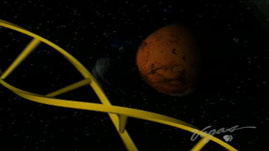Teachers' Domain - Digital Media for the Classroom and Professional Development
User: Preview

Source: Vegas PBS SAT-CHAT Series: “Astro CHAT”
This video from the Science and Technology Chat series introduces astrobiology, a field of science concerned with finding life elsewhere in the universe. Learn how astrobiologists study the conditions in which life emerged on Earth and complex organisms evolved, and how this knowledge helps them in their search for other planetary bodies capable of fostering life. The video features remote-sensing technologies, such as satellites, and mechanical rovers that can collect data from other planets or moons to assist these scientists in their search.
Astrobiologists are scientists who search our solar system and beyond for life. Their field of research lies at the intersection of biology, geology, astronomy, and planetary science. To help guide their search, astrobiologists use information about the origin and evolution of life on Earth.
For life to exist, three main ingredients must be present: naturally occurring elements, a source of energy, and a medium in which chemical reactions can occur. On Earth, carbon (the basis of all organic molecules), our Sun, and liquid water fulfill these requirements. While elements and solar energy are readily available elsewhere in the universe, a medium in which chemical reactions can occur has yet to be found.
So-called "Goldilocks" planets, which, like Earth, are positioned neither too close nor too far from their source of energy, are thought to have the greatest potential for supporting life. The presence of an atmosphere, which helps moderate temperature, also increases the likelihood that a planet could sustain life. Once scientists have determined that a planet or moon shows evidence of past or present conditions that might be conducive to life—for example, geological formations that suggest dried-up riverbeds—they can begin to look for evidence of simple life forms analogous to bacteria.
To conduct their search for life, astrobiologists use advanced imaging equipment and robotics. New types of radar can penetrate thick, gaseous atmospheres and allow for the examination of the surface of distant planets and moons. Unmanned probes can collect samples and analyze the chemistry of interstellar space. Mechanical rovers have been used to collect data on Mars in the search for evidence of past or present conditions that could nurture life. Astrobiologists have also tested meteorites and impact sites discovered on Earth for organic compounds that may have originated in outer space, including sugar-related compounds that may have been part of the chemical building blocks that produced life on Earth.
In recent years, scientists have discovered more than a hundred extrasolar planets. These are planets that orbit stars other than the Sun. Despite technological advances, many of these discoveries still rely on indirect evidence that such planets exist, especially the smaller, Earth-sized ones that might best be able to sustain life. One way that scientists can detect the presence of a planet without actually visualizing it involves observing a distant star's position in space. Any change, or "wobble," suggests the gravitational influence of a planet-sized mass rotating around it. Perhaps the next generation of imaging equipment will allow astrobiologists to directly visualize smaller planetary bodies.
 Loading Standards
Loading Standards